Abstract
In a recent paper, we constructed the spectral energy distributions (SEDs) for 1425 Fermi blazars. We classify them as low synchrotron peak sources (LSPs) if log 14.0, intermediate synchrotron peak sources (ISPs) if , and high synchrotron peak sources (HSPs) if . We obtain an empirical relation to estimate the synchrotron peak frequency, from effective spectral indexes as if , and if , where and . In the present work, we investigate the correlation between the peak frequency and the radio-to-X-ray spectral index, between peak luminosity (bolometric luminosity) and γ-ray/optical luminosity, and between peak luminosity and bolometric luminosity. Some discussion is presented.
1. Introduction
Blazars show rapid variability, high and variable polarization, superluminal motions, core-dominated non-thermal continuum, and strong γ-ray emission, [1,2,3,4,5,6,7,8,9,10,11,12,13,14,15,16,17,18,19,20,21,22,23,24]. Blazars consist of two subclasses, namely BL Lacertae objects (BL Lacs) and flat spectrum radio quasars (FSRQs). Both subclasses have common continuum properties, while their emission line features are quite different. Namely, FSRQs have strong emission lines, while BL Lacs have no or very weak emission lines. The spectral energy distributions of blazars consist of two bumps; the first one, for which synchrotron radiation is responsible, peaks at infrared/optical or UV/X-ray or even higher energy bands; the second one, peaking in the GeV or TeV bands, is often attributed to the inverse Compton process.
In 2010, [25] calculated the SEDs for 48 Fermi blazars, and proposed the subclasses of blazars using the acronyms LSP (low synchrotron peak source), ISP (intermediate synchrotron peak source), and HSP (high synchrotron peak source) as: LSPs if log 14, ISPs if , and HSPs if . An empirical function is suggested for the estimation of peak frequency using the effective spectral indexes. Quite recently, we calculated the spectral energy distributions (SEDs) for 1425 Fermi blazars and successfully obtained SEDs for 1392 sources [26]. Based on that paper, we will investigate some correlations statistically.
The spectral index α is defined as , and all luminosities are denoted simply by .
2. Sample and Classifications
In our previous paper [26], SEDs were calculated for a sample of 1425 Fermi detected blazars selected from the Fermi LAT third source catalog (3FGL) [1] by fitting the following relation with a least square fitting method: where , , and are constants, with being the spectral curvature, the peak frequency (), and peak flux (). However, SEDs were obtained for only 1392 sources, among which 999 have known redshift. When the Bayesian Information Criterion (BIC) is adopted to the logarithmic of frequency in the comoving frame for 999 sources, the following criteria were proposed for the classifications:
- for LSPs,
- for ISPs, and
- for HSPs.
When the averaged redshifts are adopted to the redshift unknown sources, and based on the criteria, we have that 34.77% of the whole sample are LSPs, 40.09% are ISPs, and 25.14% are HSPs for 1392 blazars.
In 2010, Abdo et al. [25] presented an empirical relation to estimate the synchrotron peak frequency from effective spectral indexes and . Following their work, we obtain an empirical relation to estimate the synchrotron peak frequency, from effective spectral indexes as
where and . The estimated peak frequency and the fitted peak frequency follow a linear correlation, with a correlation coefficient and a chance probability ; this is shown in Figure 1.
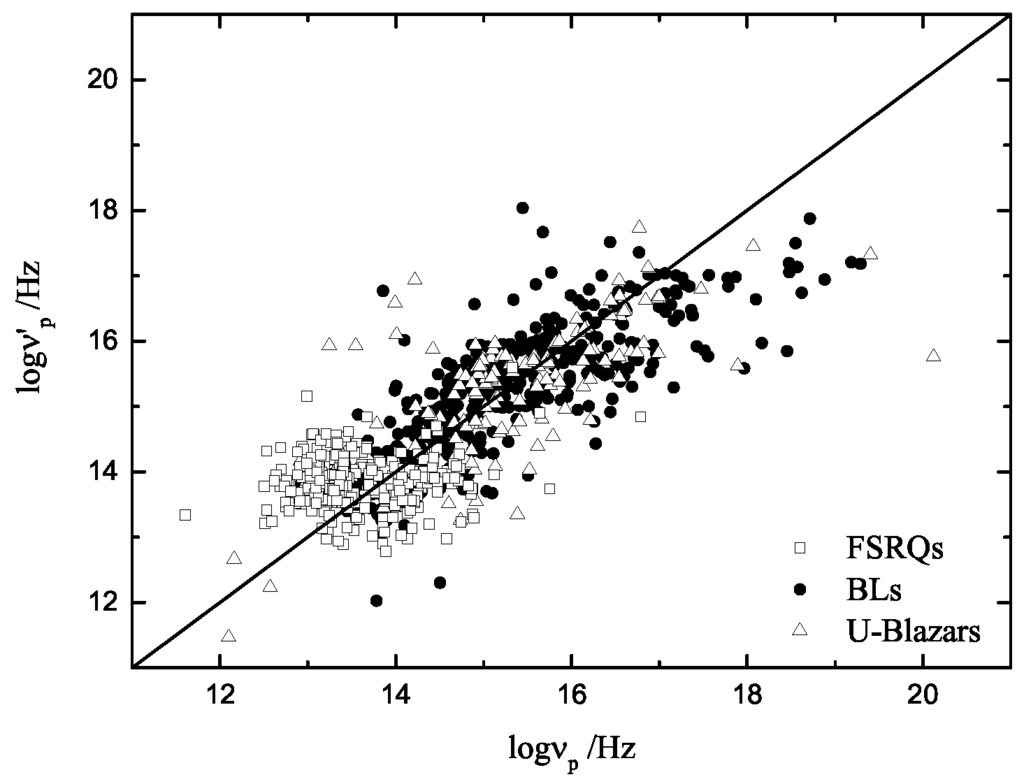
Figure 1.
Correlations between estimated peak frequency using the empirical function and the fitted peak frequency for different classes of blazars. The solid line stands for the best-fit result. BL: BL Lacertae object; FSRQ: flat spectrum radio quasars.
3. Correlations
In our previous work [26], we list broad band spectral indexes ( and ), peak frequency (), bolometric luminosity (), peak luminosity (), and monochromatic luminosity at radio, optical, X-ray, and γ-ray bands. From the data, we obtain that with a correlation coefficient r = 0.825 and a chance probability , with r = 0.810 and , with r = 0.818 and , with r = 0.990 and , with r = 0.818 and , and with r = 0.837 and for the whole sample. The linear analysis results for the whole and the subclasses are listed in Table 1, and the corresponding Figures are shown in Figure 2, Figure 3, Figure 4 and Figure 5.

Table 1.
Some correlation results for Fermi blazars.
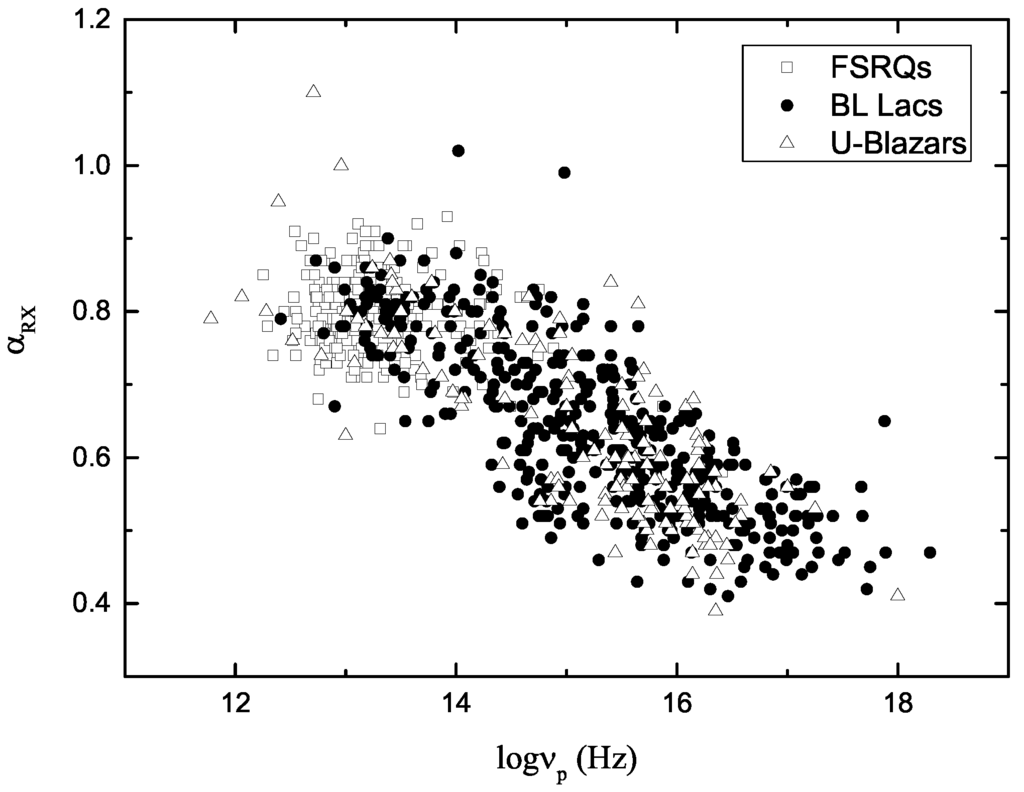
Figure 2.
The correlations between spectral index and peak frequency ().
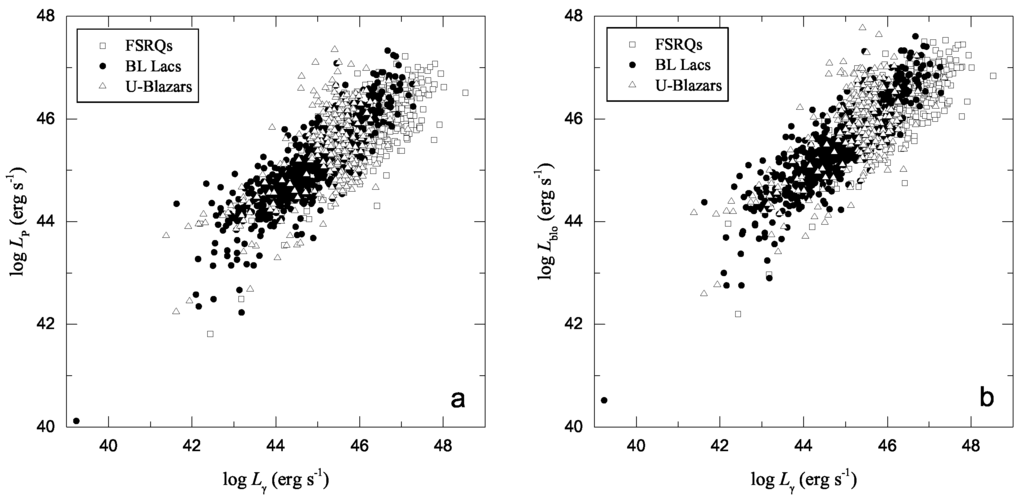
Figure 3.
The correlations between γ-ray luminosity ( at 1 GeV) and peak luminosity () (a); and bolometric luminosity () (b).
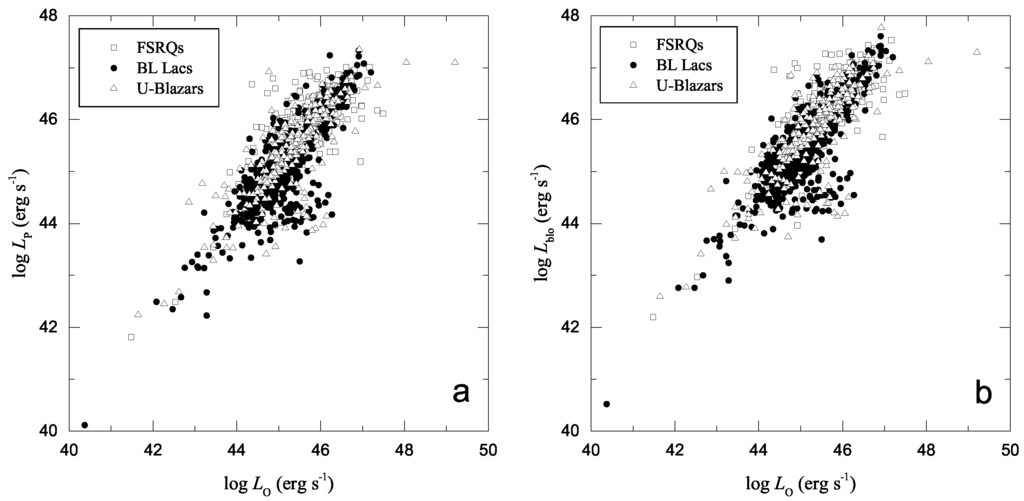
Figure 4.
The correlations between optical luminosity () and peak luminosity () (a); and bolometric luminosity () (b).
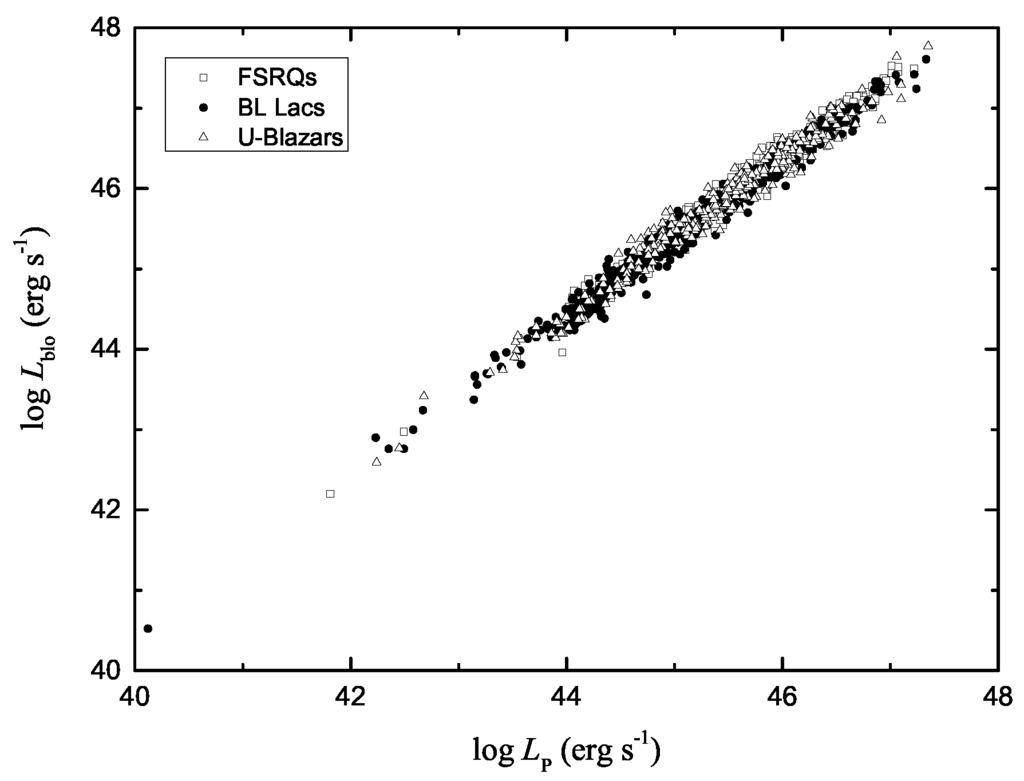
Figure 5.
The correlations between bolometric luminosity () and peak luminosity ().
4. Discussion and Conclusions
When the Bayesian Information Criterion (BIC) was adopted to the comoving peak frequencies, we found that three components are enough to fit the peak frequency distribution, and proposed the boundaries for subclasses as for LSPs, for ISPs, and for HSPs. This classification is quite similar to that of [25]. There is no extreme high peak frequency component. We also proposed a function to estimate the peak frequency by using effective spectral indexes. From the comparison shown in Figure 1, we can see that the empirical function can estimate the peak frequency well when peak frequency is lower than , but the estimated peak frequency is under-estimated when .
Figure 2 shows that there is an anti-correlation between the effective spectral index and the peak frequency for the whole sample. However, we can see that there is a tendency for to increase with for lower peak frequency sources. When the peak frequency moves to the lower side, then the X-ray emission will increase, since they are the sum of the synchrotron emission tail and the inverse Compton emission. Therefore, will decrease, resulting in the positive tendency.
We also investigate the correlation between the peak luminosity/bolometric luminosity and γ-ray luminosity. We have found a very strong correlation. Similar results are also found between the peak luminosity/bolometric luminosity and optical luminosity. This means that we can use γ-ray (or optical) luminosity to estimate the peak luminosity/bolometric luminosity and γ-ray luminosity.
In this work, we introduce the classification of subclasses of blazars and an empirical function of peak frequency estimation using effective spectral indexes, investigate the correlation between effective radio-to-X-ray spectral index and peak frequency, as well as the correlation between peak/bolometric luminosity and γ-ray/optical luminosity. Conclusions are:
- (1)
- There are only three subclasses of Fermi blazars (LSPs, ISPs, and HSPs), and there is no extreme high peak frequency component for blazars. On the contrary, there are extreme blazars not detected by Fermi but detected by Cherenkov telescope;
- (2)
- There is an anti-correlation between broad band spectral index () and peak frequency;
- (3)
- Peak frequency can be estimated using the broad band spectral indexes;
- (4)
- The peak/bolometric luminosity can be estimated using γ/optical luminosity;
- (5)
- There is a very significant correlation between peak and bolometric luminosity.
Acknowledgments
This work is supported by the National Natural Science Foundation of China (U1531245, U1431112, 11203007, 11403006, 11503004, 10633010, 11173009), and the Innovation Foundation of Guangzhou University (IFGZ), Guangdong Province Universities and Colleges Pearl River Scholar Funded Scheme(GDUPS)(2009), Yangcheng Scholar Funded Scheme(10A027S), and supported for Astrophysics Key Subjects of Guangdong Province and Guangzhou City. This work was presented in “Blazars through Sharp Multi-Wavelength Eyes”, Malaga (Spain), 30 May–3 June, 2016.
Author Contributions
Junhui, Fan is responsible for the writing and the motivation of the paper; Yi, Liu is responsible for the classification; Jianghe, Yang for the SED calculation, Chao, Lin for the figures and linear correlation analysis, Jingmeng, Hao and Hubing, Xiao for some discussions.
Conflicts of Interest
The authors declare no conflict of interest.
References
- Acero, F.; Ackermann, M.; Ajello, M.; Albert, A.; Atwood, W.B.; Axelsson, M.; Baldini, L.; Ballet, J.; Barbiellini, G.; Bastieri, D.; et al. Fermi Large Area Telescope Third Source Catalog. Astrophys. J. Suppl. Ser. 2015, 218, 23–63. [Google Scholar] [CrossRef]
- Ackermann, M.; Ajello, M.; Atwood, W.B.; Baldini, L.; Ballet, J.; Barbiellini, G.; Bastieri, D.; Gonzalez, J.B.; Bellazzini, R.; Bissaldi, E.; et al. The Third Catalog of Active Galactic Nuclei Detected by the Fermi Large Area Telescope. Astrophys. J. 2015, 810, 14–47. [Google Scholar] [CrossRef]
- Aller, M.F.; Aller, H.D.; Hughes, P.A. Radio Band Observations of Blazar Variability. J. Astrophys. Astron. 2011, 32, 5–11. [Google Scholar] [CrossRef]
- Bai, J.M.; Xie, G.Z.; Li, K.H.; Zhang, X.; Liu, W.W. The intraday variability in the radio-selected and X-ray-selected BL Lacertae objects. Astron. Astrophys. Suppl. Ser. 1998, 132, 83–92. [Google Scholar] [CrossRef]
- Bastieri, D.; Ciprini, S.; Gasparrini, D. Fermi-LAT View of Bright Flaring Gamma-Ray Blazars. J. Astrophys. Astron. 2011, 32, 169–172. [Google Scholar] [CrossRef]
- Fan, J.H.; Xie, G.Z. The properties of BL Lacertae objects. Astrophys. Astron. 1996, 306, 55–60. [Google Scholar]
- Fan, J.H.; Yang, J.H.; Liu, Y.; Zhang, J.Y. The gamma-ray Doppler factor determinations for a Fermi blazar sample. Res. Astron. Astrophys. 2013, 13, 259–269. [Google Scholar] [CrossRef]
- Fan, J.H.; Bastieri, D.; Yang, J.H.; Liu, Y.; Hua, T.-X.; Yuan, Y.-H.; Wu, D.-X. The lower limit of the Doppler factor for a Fermi blazar sample. Res. Astron. Astrophys. 2014, 14, 1135–1145. [Google Scholar] [CrossRef]
- Gu, M.F.; Li, S.L. The ultraviolet/optical variability of steep-spectrum radio quasars: The change in accretion rate? Astron. Astrophys. 2013, 554, A51. [Google Scholar] [CrossRef]
- Gu, M.F. Spectral Variability in Radio-Loud Quasars. J. Astrophys. Astron. 2014, 35, 369–372. [Google Scholar] [CrossRef]
- Gupta, A.C. UV and X-ray Variability of Blazars. J. Astrophys. Astron. 2011, 32, 155–161. [Google Scholar] [CrossRef]
- Gupta, A.C.; Krichbaum, T.P.; Wiita, P.J.; Rani, B.; Sokolovsky, K.V.; Mohan, P.; Mangalam, A.; Marchili, N.; Fuhrmann, L.; Agudo, I.; et al. Multiwavelength intraday variability of the BL Lacertae S5 0716+714. Mon. Not. R. Astron. Soc. 2012, 425, 1357–1370. [Google Scholar] [CrossRef]
- Hu, S.M.; Zhao, G.; Guo, H.Y.; Zhang, X.; Zheng, Y.G. The optical spectral slope variability of 17 blazars. Mon. Not. R. Astron. Soc. 2006, 371, 1243–1250. [Google Scholar] [CrossRef]
- Lin, C.; Fan, J.H. Comparison between TeV and non-TeV BL Lac Objects. Res. Astrophys. Astron. 2016, 16, 88. [Google Scholar] [CrossRef]
- Romero, G.E.; Cellone, S.A.; Combi, J.A.; Andruchow, I. Optical microvariability of EGRET blazars. Astron. Astrophys. 2002, 390, 431–438. [Google Scholar] [CrossRef]
- Urry, M. Gamma-Ray and Multiwavelength Emission from Blazars. J. Astrophys. Astron. 2011, 32, 139–145. [Google Scholar] [CrossRef]
- Wehrle, A. Multi-wavelength studies of blazars BL Lac and 3C454.3. In Proceedings of the Blazars through Sharp Multi-Wavelength Eyes, Malaga, Spain, 30 May–3 June 2016.
- Wills, B.J.; Wills, D.; Breger, M.; Antonucci, R.R.J.; Barvainis, R. A survey for high optical polarization in quasars with core-dominant radio structure—Is there a beamed optical continuum? Astrophys. J. 1992, 398, 454–475. [Google Scholar] [CrossRef]
- Wu, Q.W.; Yuan, F.; Cao, X.W. On the Origin of X-Ray Emission in Some FR I Galaxies: ADAF or Jet? Astrophys. J. 2007, 669, 96–105. [Google Scholar] [CrossRef]
- Yang, J.H.; Fan, J.H.; Yang, R.S. The line emissions and polarization in blazars. Sci. China Phys. Mech. Astron. 2010, 53, 1162–1168. [Google Scholar] [CrossRef]
- Yang, J.H.; Fan, J.H. The central black hole masses for the γ-ray loud blazars. Sci. China Phys. Mech. Astron. 2010, 53, 1921–1927. [Google Scholar] [CrossRef]
- Yang, J.H.; Fan, J.H.; Yuan, Y.H. Lorentz factor estimation for radio sources. Sci. China Phys. Mech. Astron. 2012, 55, 1510–1514. [Google Scholar] [CrossRef]
- Yang, J.H.; Fan, J.H.; Nie, J.J.; Yang, R.S. The gamma-ray spectral index changes for blazars. Sci. China Phys. Mech. Astron. 2012, 55, 2179–2185. [Google Scholar] [CrossRef]
- Yang, J.H.; Fan, J.H.; Hua, T.X.; Wu, D.X. The γ-ray emission mechanism for Fermi Blazars. Astrophys. Space Sci. 2014, 352, 819–824. [Google Scholar] [CrossRef]
- Abdo, A.A.; Ackermann, M.; Agudo, I.; Ajello, M.; Aller, H.D.; Aller, M.F.; Angelakis, E.; Arkharov, A.A.; Axelsson, M.; Bach, U.; et al. The Spectral Energy Distribution of Fermi Bright Blazars. Astrophysi. J. 2010, 716, 30–70. [Google Scholar] [CrossRef]
- Fan, J.H.; Yang, J.H.; Liu, Y.; Luo, G.Y.; Lin, C.; Yuan, Y.H.; Xiao, H.B.; Zhou, A.Y.; Hua, T.X.; Pei, Z.Y. The Spectral Energy Distributions of Fermi Blazars. Astrophys. J. Suppl. Ser. 2016, in press. [Google Scholar]
© 2016 by the authors; licensee MDPI, Basel, Switzerland. This article is an open access article distributed under the terms and conditions of the Creative Commons Attribution (CC-BY) license (http://creativecommons.org/licenses/by/4.0/).